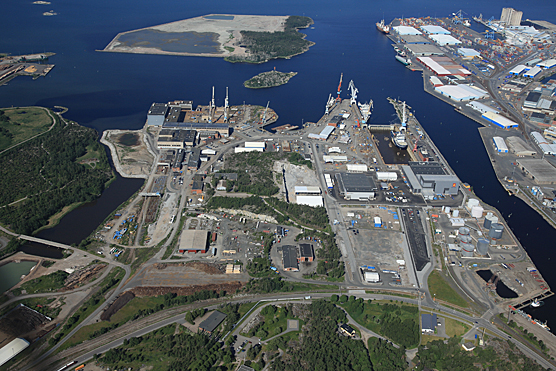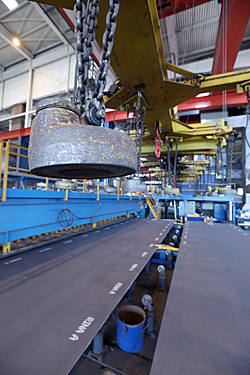
Rauma Seaside Industry Park. © Rauman meriteollisuuskiinteistöt
Rauman Meriteollisuuskiinteistöt analyses the electricity, district heating and water consumption of its tenants. Knowing the consumption of the real estate helps discover savings.
Providing facilities for 30 industrial operators, Rauman Meriteollisuuskiinteistöt Oy has launched an extensive energy-saving project. After gaining experiences from the pilot stage, the project is intended to cover all the real estate in the Seaside Industry Park, more than 50,000 m2 of properties. The project is part of the six-year Canemure project aiming to implement the climate targets of the EU by reducing carbon dioxide emissions.
Smart measurements
The pilot project focuses on an intelligent measuring and monitoring system on the use of various forms of energy and resources at the Seaside Industry Park. The system monitors electricity, heating, water, compressed air and gas. The main goal of the project is reducing consumption.
“Our goal is to achieve savings of 30% in proportion to production and a 30% reduction in CO2 emission,” says Timo Luukkonen, Managing Director of Rauman Meriteollisuuskiinteistöt.
The invoices for the various resources of the tenants at Seaside Industry Park have so far been based on assessments of use. This has been because the facilities have not had separate meters of electricity, heat or water consumption for each operator. The reason for this is that the area was previously used by a single operator, Rauma-Repola. Rauman Meriteollisuuskiinteistöt was established in 2014.
As the invoicing has been based on assessments, the businesses have not have sufficient motivation to operate resource-wisely.
“As our new system starts providing information on the consumption of each operator, the savings potential will become more evident and the operators will be able to influence their energy and water bills by making their operations more efficient. We aim to offer all of the businesses real-time information on the use of various resources through the system in the future,” says Luukkonen.
From raw data to analytics
In the spring of 2020, the new measuring and monitoring system was first installed in the facilities of Logistikas, a company providing preprocessing services for the metal industry.
However, simply collecting data and presenting raw data is not enough; the large mass of data must be sifted through to find the truly important pieces of information. For this process, the Seaside Industry Park is partnering with the Rauma-based software company ionSign Oy that develops data analytics and reporting for the needs of various user groups in the system. The development work will continue throughout the project so that the needs of different user organisations can be met.
“It is important for us and our customers that we can scale the savings achieved through the system in proportion to the production volumes. In maritime industry companies, the production and the use of resources varies greatly from year to year and season to season,” says Development Coordinator Saara Haaslahti.
More meters will be gradually added to the area in the next few years.
“In the project, we focus on production buildings as they have the greatest potential for savings,” says Haaslahti.
The energy consumption in the entire 40-hectare area varies around one million kilowatt-hours each month. The consumption of district heating usually reaches its maximum of about 1,500 megawatt-hours in January. Water consumption varies between 1,000 and 1,500 cubic metres.
The companies in the area have been interested in the project from the beginning as they see an opportunity to decrease both their invoices and their emissions. However, in the initial stages, property-specific meters may yield positive or negative surprises as some companies may receive larger invoices than usual as the amounts correspond to the actual consumption.
“It is important that the companies see their consumption in real time through the new system, thus having the opportunity to influence their operations while the process is ongoing. I believe the operators consuming large amounts of energy will be able to significantly reduce their energy bills,” says Luukkonen.
The entire area in one view

© Jussi Partanen
Seaside Industry Park Rauma proves that the ongoing project could also benefit other industrial parks and real estate companies providing facilities for a large number of companies. At Seaside Industry Park, both the owner of the properties and the tenants benefit from the system.
“We are able to gather all the consumption data of the area under one interface while offering diverse information to our customers,” says Haaslahti.
For the maintenance manager of Meriteollisuuskiinteistöt, the system offers the opportunity to notice if a facility’s water or heating consumption rises rapidly, for example. The system can be set up to send an alert in such situations so that the maintenance manager can check the HPAC systems of the facility for leaks.
“One monitoring system for all the facilities and their consumption meters makes our maintenance work considerably easier. Another important factor is the clear and equal new invoicing system,” says Haaslahti.
Quick payback
In the future, the locations of the meters will be even more specific to obtain information on the electricity consumption of lighting, machinery, charging devices and electric ventilation and cooling systems.
“Once the system is extensively put to use, our processes will allow the companies to discuss and share their best practices of achieving energy-saving targets,” says Luukkonen.
Haaslahti has some advice for those interested in building a similar system. “Planning the measurements, in other words the locations of the consumption meters, is very important. You can’t install a countless number of meters. Another major factor is designing the interface to be user-friendly. This is a long project that enables us to constantly learn things and apply them to practice.”
The budget for the entire project is about EUR 400,000, of which about EUR 160,000 comes from the EU. As the annual electricity bill of Rauman Meriteollisuuskiinteistöt is about one million euros and the heating bill about half a million euros, the investment’s payback period is very short as long as the set energy-saving targets are reached. This also cuts back the carbon dioxide emissions and helps protect the climate.
Author: Jukka Nortio
The article was published in the Hiilineutraali Suomi journal in September 2020 (in Finnish).
Read more